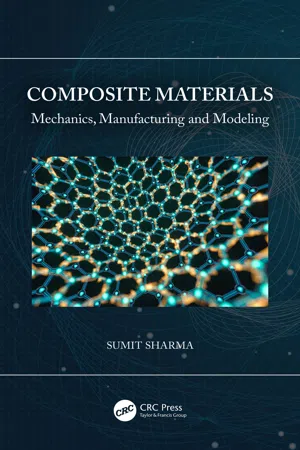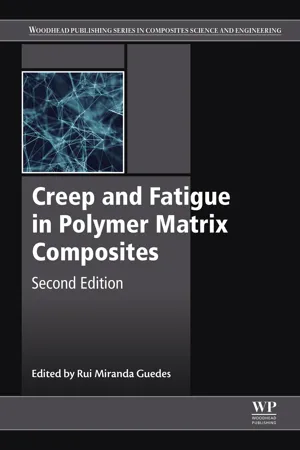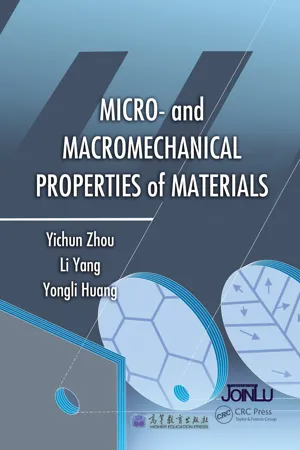Technology & Engineering
Viscoelasticity
Viscoelasticity refers to the property of materials that exhibit both viscous (flowing) and elastic (rebounding) behavior when subjected to stress. This means they can deform and return to their original shape over time. Viscoelastic materials are commonly found in products like adhesives, gels, and certain plastics, and their behavior is important in various engineering applications, such as in damping vibrations and shock absorption.
Written by Perlego with AI-assistance
Related key terms
Related key terms
1 of 4
Related key terms
1 of 3
10 Key excerpts on "Viscoelasticity"
- eBook - ePub
Modeling and Computing for Geotechnical Engineering
An Introduction
- M.S. Rahman, M.B. Can Ulker(Authors)
- 2018(Publication Date)
- CRC Press(Publisher)
The response of such materials is time-dependent with the deformation being dependent upon the rate at which the loads are applied. Modeling of such time-dependent material is available in the framework of the theory of Viscoelasticity. Viscoelasticity consists of two components: viscosity and elasticity. Viscosity is a measure of resistance to flow, which is a fluid property while elasticity is a characteristic of solids. In general, those materials whose mechanical response to external loads combines the features of both elastic solids and viscous fluids are called viscoelastic. The models presented thus far are rate-independent. That is, stress-strain relationship as well as material strength are not functions of time or the rate of change of them over time is not included in the formulation. It is indeed possible and sometimes preferable to include rate- dependent behavior of engineering materials. Their time-dependent stress-strain relationships matter in determining the overall response to loads which means in this context that the deformation of the material depends on the rate at which loads are applied. Viscoplasticity based models can incorporate the inelastic strains. In a sense, viscoplasticity is the rate-dependent version of plasticity where material exhibits permanent deformations but over time. Viscoplastic constitutive equations are used to model the behavior of materials that are subjected to stresses at high temperatures and to model the behavior of materials that are deformed at high strain rates. In this chapter, the focus is on understanding the basic elements of Viscoelasticity. First, a number of rheological models consisting of simple springs and dashpots are presented. Some composite forms of these fundamental models are then presented to formulate stress-strain relationships for a rate-dependent material - eBook - ePub
Composite Materials
Mechanics, Manufacturing and Modeling
- Sumit Sharma(Author)
- 2021(Publication Date)
- CRC Press(Publisher)
16 Viscoelastic and Dynamic Behavior of Composites Composite structures are often subjected to dynamic loading caused by vibration or wave propagation. In addition, many composites exhibit time-dependent viscoelastic behavior under load; this is particularly true for composites having polymeric constituents. This chapter contains the basic information needed for the analysis of both viscoelastic and dynamic behavior of composites and their constituents. The word “viscoelastic” has evolved as a way of describing materials that exhibit characteristics of both viscous fluids and elastic solids. Polymeric materials, which are known to be viscoelastic, may behave like fluids or solids, depending on the timescale and/or the temperature. For example, polycarbonate, a thermoplastic polymer, is a liquid during molding at processing temperatures, but is a glassy solid at service (ambient) temperatures. It will deform like a rubber at temperatures just above the glass transition temperature, T g. At temperatures below T g, however, it will deform just as much, and in the same way if the test time is long enough. We know that ideal Hookean elastic solids are capable of energy storage under load, but not energy dissipation, whereas ideal Newtonian fluids under non-hydrostatic stresses are capable of energy dissipation, but not energy storage. Viscoelastic materials, however, are capable of both storage and dissipation of energy under load. Another characteristic of viscoelastic materials is memory. Perfectly elastic solids are said to have only “simple memory” because they remember only the unstrained state and the current strains depend only on the current stresses - eBook - ePub
- Rui Miranda Guedes(Author)
- 2019(Publication Date)
- Woodhead Publishing(Publisher)
− 3 Ωm.1.6 Viscoelastic behavior of polymers
By viscoelastic behavior we mean exactly a behavior in which the response of the material to a specific excitation is time-dependent. Thus, in plastics whose behavior is predominantly viscoelastic, it is observed that stiffness, strength, ductility, and other properties are sensitive to the rate of deformation (indirect dependence on time), the loading rate, the strain or stress history, temperature, and heating or cooling rate.To study the viscoelastic behavior of these materials, different types of experiments are executed, the most basic of which are creep, relaxation, and creep-recovery. Creep is the phenomenon in which the deformation that develops in a body at constant tension and at constant temperature and humidity increases with time.During creep, there is a change in stiffness of the material that comes up against time. Knowing the law governing this change is very important for the proper design of plastic parts or other products. Metals also exhibit viscoelastic behavior, but this is evident only in particularly high temperatures. At ambient temperature, polymers show a strong creep while the creep of metals is negligible. Thus, all materials flow and, depending on environmental conditions and the different loads applied, their creep is more or less intense.Relaxation is the phenomenon in which the stress that develops in a body in constant distortion, temperature, and humidity conditions decreases over time. Creep-recovery is the phenomenon observed in a body immediately after reduction of the fixed imposed creep load and in which deformation decreases exponentially over time.In most design cases with traditional materials, the purpose of the design is to determine the allowable stresses. Conversely, in plastics, the limiting factor is the determination of the deformation that will develop material failure stresses. - Maxim Arzhakov(Author)
- 2019(Publication Date)
- CRC Press(Publisher)
1 Viscoelasticity and relaxation The mechanical properties of physical bodies, including polymers, determine their response to external force.Under the stress σ = F/Sc.s. , where F is the applied force, Sc.s. is the cross-sectional area of the sample, the physical body is deformed, changing the shape and dimensions.The amount of strain is estimated as the relative change in the body size. For example, in the case of uniaxial tension, deformation is defined asε =, where l is the linear dimension of the deformed body; l0 is the original linear dimension.l −l 0l 0The relationship between stress and strain is described by two basic laws:for ideal elastic bodies – Hooke’s lawσ = E ε ,(1.1) where E is the elastic modulus or Young’s modulus.for ideal liquids – Newton’s lawσ = η,d εd t(1.2) where η is the viscosity of the liquid; dε/dt is the strain rate or the velocity of the viscous flow.In the vast majority of cases, the behaviour of real condensed bodies, especially polymers, is a combination of elasticity and viscous flow. This behaviour is denoted as Viscoelasticity, and similar bodies are called viscoelastic.The relaxation nature of Viscoelasticity manifests itself as a dependence of the mechanical behaviour of the material on the time of observation or on the time of the force action.For example, if you watch a piece of bitumen for an hour, then during this period of time it will completely retain its volume and shape, which is a sign of a solid. The flow of bitumen at room temperature under the influence of its own weight, i.e. liquid-like behaviour while maintaining volume, but not shape, becomes noticeable only when the observation time increases to several weeks. The same bitumen under impact loading demonstrates a response typical of an elastic solid and is described by Hooke’s law. When force is applied to the sample for a long time, bitumen flows like a viscous liquid, in accordance with Newton’s law.- Yichun Zhou, Li Yang, Yongli Huang(Authors)
- 2013(Publication Date)
- CRC Press(Publisher)
12 Mechanical Properties of Polymer MaterialsPolymers are an important category of engineering materials, and are widely used in a variety of areas such as mechanical, construction, automotive, electrical appliances, light industry, electronics, and aerospace. Because of their unique molecular chain structures and aggregation structures, polymers have different physical properties compared with other materials, especially their mechanical properties. The mechanical properties of a polymer strongly depend on the conditions of temperature, loading time, deformation rate, and load frequency. Usually—depending on different temperatures and the time of observation—a polymer shows different mechanical behaviors including the glassy state, the viscoelastic state, the high-elastic state (hyperelastic or rubbery state), and the viscous flow state. As a structural material, the main features of a polymer’s mechanical properties are its Viscoelasticity and its hyperelasticity. This chapter will introduce Viscoelasticity and its mechanical models, the hyperelasticity of polymer materials, and the yield and pattern of the brittle–ductile transition of polymer materials.12.1 Viscoelasticity of High Polymer
In understanding substances and materials, human beings first became familiar with two types of materials: elastic solids and viscous fluids. Elastic solids have specific volumes and configurations, and their stress state and deformation are time-independent when subject to static loads. Elastic solids can be fully restored after the external force is removed. The work done by external forces in the elastic deformation process is not only stored in the form of elastic potential energy, but is also completely released in the process of unloading. On the contrary, viscous fluids do not have determined volumes and configurations, and their shapes depend on the container. Under external forces, they continually deform over time, resulting in an irreversible flow. When deformation movement occurs, the adjacent fluid layers will cause internal friction that consumes energy. In general, polymer materials are neither attributable to the elastic solid, nor attributable to the viscous fluid. They often have the characteristics of both elastic solids and viscous fluids, and comprehensively show the two different mechanisms of elastic and viscous deformations. This property of substances is called Viscoelasticity [1- eBook - ePub
- Maria Cristina Tanzi, Silvia Farè(Authors)
- 2017(Publication Date)
- Woodhead Publishing(Publisher)
Rheological characterization is an important tool to define the relation structure-properties of polymeric biomaterials, to tailor their properties for the specific application, and to mimic the rheological properties of the tissues to be repaired or augmented. Rheological investigations, moreover, can play an important role in assessing the advantage of polymeric systems for a specific application keeping into account the mechanical history which should be experienced along the entire route leading to their in situ performance. In this chapter, the apparatus and experimental tests that are used for rheological characterization of polymeric biomaterials along with the most common rheological behaviors of the biomaterials will be discussed.Keywords
Rheometers; Viscosity; Viscoelasticity; Creep tests; Stress relaxation tests; Flow curve; Dynamic moduli; Hydrogels; Polymeric solutions10.1 Introduction
Rheology is the study of the flow properties and deformation behavior of matter that cannot be described by the continuum mechanics that is the elasticity theory and fluid dynamics. Complex systems, such as polymeric and disperse systems, show mechanical responses intermediate between those of liquids and solids because they are composed of both viscous and elastic component. Viscoelastic and nonlinear features depend upon both type and magnitude of the field conditions, like a strain or local stresses so also on their extent and variation over time. Accordingly, several material functions must be used to fully characterize the viscoelastic responses even under simple kinematic conditions. Furthermore, for a viscoelastic system the balance between viscous and elastic components depends on the timescale at which the system is probed and it can be described by the Deborah number (De ), a dimensionless quantity defined as ratio between the relaxation time of material, λ , and a time constant, Λ, which is a characteristic time of the deformation process being observed. When De is high (≫1) since the time of relaxation is greater than the time of observation the system behaves like an elastic solid and the material can be considered a solid for all practical purposes, while if the time of observation is very long, or the time of relaxation is very small De - eBook - ePub
Fundamentals of Polymer Science
An Introductory Text, Second Edition
- Michael M. Coleman, Paul C. Painter(Authors)
- 2019(Publication Date)
- CRC Press(Publisher)
This is a good approximation of some materials, but for polymers we must consider how these properties usually occur together, which brings us to the topic of Viscoelasticity. D. INTRODUCTION TO Viscoelasticity We have noted in the preceding paragraphs that when we stretch or otherwise deform a crystalline solid, elastic energy is stored in the stretched (or compressed) bonds and this provides the means for the material to return to its original shape upon removal of the load (assuming this was not a load large enough to break bonds, or induce slip along crystalline planes, etc.) In contrast, upon application of a shear stress to a Newtonian fluid, the energy is immediatly dissipated in flow. Upon removal of the stress there is no elastic recovery. Some simple liquids and highly crystalline solids under small loads and deformations may approach these poles of ideal behavior, but most display characteristics that are between and their response is called viscoelastic. Viscoelastic behavior has actually been observed throughout recorded history. Archers in medieval times (and before), for example, knew never to leave their bows strung when not in use, because the tension in the bowstring would decrease over time as the wood in the bow “relaxed” and accommodated itself to the continuous load. Some of the first systematic studies of this phenomena were conducted by Weber (1835) *, who noted that silk fibers displayed an immediate elastic deformation upon loading that was followed by an extension that gradually increased with time. Similarly, upon removing the load he observed both an immediate and delayed contraction. In many of the materials studied by Weber, such as glass and silver, “primary creep”, which is the reversible component of the delayed deformation (there is often an irreversible component referred to as “secondary creep”), is usually a small proportion of the instantaneous elastic deformation (about 3%) - Nicholas P. Cheremisinoff, Paul N. Cheremisinoff(Authors)
- 2020(Publication Date)
- CRC Press(Publisher)
In the dynamic mechanical tests, either a vibrational force or a deformation is applied to the specimen, and then the sinusoidal response of either the deformation or force is measured, respectively. The dynamic mechanical properties are measured as a function of frequency at a constant temperature or as a function of temperature. The temperature dependence of dynamic Viscoelasticity is conveniently used by the plastic industry to characterize solid polymers. Recently, various kinds of equipment for measuring dynamic Viscoelasticity are commercially available and widely used for scientific and practical purposes.In this chapter, we outline the principle, measurement, and application of dynamic Viscoelasticity for solid and liquid polymers. In Section II , a basic treatment of the dynamic Viscoelasticity is described. Section III deals with the various dynamic viscoelastic measurements of solid and liquid polymers. Section IV reviews in detail the results of linear dynamic Viscoelasticity as a function of frequency and temperature. The dynamic mechanical studies have been also extended to curing reaction, thermal degradation and photodegradation and to the measurements in relative humidity and in water.II. PRINCIPLE OF DYNAMIC Viscoelasticity
Polymers are interesting materials that have both elastic solid and viscous liquid characteristics, namely, Viscoelasticity. Elasticity is expressed by a spring model as shown in Fig. 1A . When the stress, σ, which acts on the specimen, and strain, ε, are measured by using the stretching test, their relationship is given by Hook’s law as
withσ = E ε(1) ε = Δ l /l 0where E is the elastic or Young’s modulus, Δl is the deformation, and l0 is the original length of the specimen. Elastic moduli can be obtained by measuring the stretching or bending, shear force, and compressive force in a specimen and are called Young’s modulus (E), shear modulus (G), and bulk modulus (B), respectively. These moduli are interrelated byE = 2 G(= 3 B1 + v)(1 − 2 v)(2) Fig. 1- eBook - ePub
- D.V. Rosato, D.V. Rosato(Authors)
- 2003(Publication Date)
- Elsevier Science(Publisher)
In the plastic, strain increases with longer loading times and higher temperatures. It is a phenomenon of time-dependent, in addition to elastic, deformation (or recovery) in response to load. This property possessed by all plastics to some degree, dictates that while plastics have solid-like characteristics such as elasticity, strength, and form-stability, they also have liquid-like characteristics such as flow depending on time, temperature, rate, and amount of loading. These basic characteristics highlight: (a) simplified deformation vs. time behavior, (b) stress-strain deformation vs. time, and (c) stress-strain deformation vs. time (stress-relaxation).A constitutive relationship between stress and strain describing viscoelastic behavior will have terms involving strain rate as well as stress and strain. If there is direct proportionality between the terms then the behavior is that of linear Viscoelasticity described by a linear differential equation. Plastics may exhibit linearity but usually only at low strains. More commonly complex non-linear viscoelastic behavior is observed.Thus Viscoelasticity is characterized by dependencies on temperature and time, the complexities of which may be considerably simplified by the time-temperature superposition principle. Similarly the response to successively loadings can be simply represented using the applied Boltzmann superposition principle. Experimentally Viscoelasticity is characterized by creep compliance quantified by creep compliance (for example), stress relaxation (quantified by stress relaxation modulus), and by dynamic mechanical response.The general design criteria applicable to plastics are the same as those for metals at elevated temperature; that is, design is based on (1) a deformation limit, and (2) a stress limit (for stress-rupture failure). There are cases where weight is a limiting factor and other cases where short-term properties are important. In computing ordinary short-term characteristics of plastics, the standard stress analysis formulas may be used. For predicting creep and stress-rupture behavior, the method will vary according to circumstances. In viscoelastic materials, relaxation data can be used to predict creep deformations. In other cases the rate theory may be used. - eBook - ePub
Mechanical Vibration
Analysis, Uncertainties, and Control, Fourth Edition
- Haym Benaroya, Mark Nagurka, Seon Han(Authors)
- 2017(Publication Date)
- CRC Press(Publisher)
Appenidx BViscoelastic Damping
“The mechanisms of energy loss .”This appendix provides an introduction to viscoelastic damping models. It generalizes the classic viscous damping model discussed in Chapter 3 .B.1 Viscoelastic MaterialsViscoelastic materials have history‐dependent properties or memory. They are commonly found in practice, and often used to remove vibrational energy. Viscoelastic material models represent material damping at very small scales where differential motions due to lattice dislocations and imperfections result in energy loss through friction‐induced thermal processes. Viscoelastic energy dissipation is primarily due to shear deformation.Where significant energy dissipation is required, composites and viscoelastic (rubberlike) materials are used. Their hysteresis loops have much larger enclosed areas than do typical materials such as steel and aluminum. A difficulty with using high damping alloys is that they have inferior stiffness properties, are not as strong as needed, and have corrosion and thermal properties that make them unsuitable for structural applications except for specialized purposes.1Fiber‐reinforced composites, on the other hand, have found extensive usage in the aerospace and automotive industries.Viscoelastic materials are generally characterized by the results of experimental testing. An example would be performing uniaxial tensile tests similar to those used for elastic solids, except these tests are modified in order to highlight the time‐dependent material response. The tests are used to demonstrate creep , stress relaxation , and sinusoidal loading .The creep test measures time‐dependent strain that results from the application of a constant uniaxial stress.2For a linear material, when the stress is doubled, for example, the resulting strain is doubled over the full range of time required to achieve the complete displacement. Stress relaxation is the reverse of creep. Here, a time‐dependent stress corresponds to a constant strain. Generally, the relaxation response moves more quickly to its equilibrium value than does the creep response.
Index pages curate the most relevant extracts from our library of academic textbooks. They’ve been created using an in-house natural language model (NLM), each adding context and meaning to key research topics.
Explore more topic indexes
Explore more topic indexes
1 of 6
Explore more topic indexes
1 of 4









